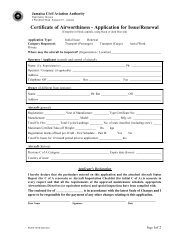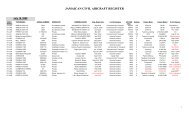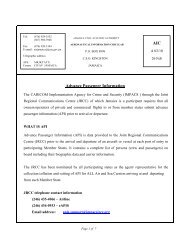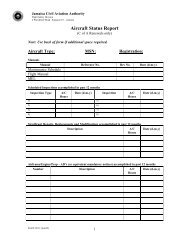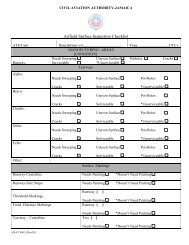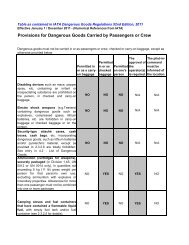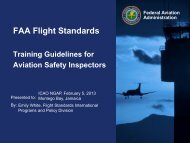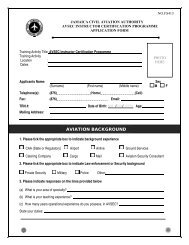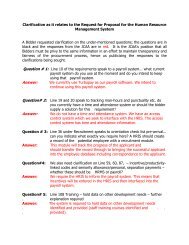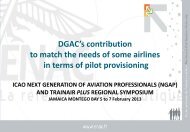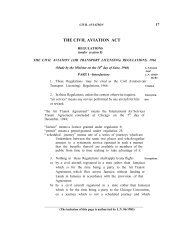Jamaica Civil Aviation Authority Aeronautical Information Service 4 W
Jamaica Civil Aviation Authority Aeronautical Information Service 4 W
Jamaica Civil Aviation Authority Aeronautical Information Service 4 W
You also want an ePaper? Increase the reach of your titles
YUMPU automatically turns print PDFs into web optimized ePapers that Google loves.
___________________________<br />
<strong>Jamaica</strong> <strong>Civil</strong> <strong>Aviation</strong> <strong>Authority</strong><br />
<strong>Aeronautical</strong> <strong>Information</strong> <strong>Service</strong><br />
4 Winchester Road<br />
Kingston 10<br />
Tel: 929-3552<br />
EMAIL: aisjamaica@jcaa.gov.jm<br />
__________________________<br />
AC<br />
01/10<br />
June 17, 2010<br />
ADVISORY CIRCULAR<br />
FLIGHT PLANNING PROCEDURES – BOSCOBEL AERODROME<br />
1. Purpose<br />
1.1 This AIS Advisory Circular (AC) provides guidance on the establishment and operations of<br />
the processes associated with flight planning within the Kingston FIR and Boscobel in<br />
particular to ensure that pilots are well informed of the requirements to facilitate safe<br />
conduct of a flight.<br />
2. Status of this AC<br />
2.1 This is the first issue of 2010 – FLIGHT PLANNING PROCEDURES dated June 17, 2010. It<br />
will remain current until withdrawn or superseded.<br />
3.0 Reference documents<br />
ICAO Annex 2, Chapter 3 – Rules of the Air<br />
ICAO Doc 4444 (PANS-ATM)<br />
ICAO Doc 7030 - Regional Supplementary Procedures, Part CAR<br />
<strong>Civil</strong> <strong>Aviation</strong> Regulations 2005,<br />
<strong>Aeronautical</strong> <strong>Information</strong> Publication/<strong>Jamaica</strong><br />
Page 1 of 8
4.0 Applicability<br />
4.1 The importance of filing a flight plan before departure from an aerodrome cannot be<br />
underscored but briefly stated - is to facilitate making the intentions of the pilot well known in<br />
advance to the relevant ATS units. This will facilitate the provision of air traffic services or<br />
use of the details provided therein to facilitate search and rescue.<br />
5.0 Procedures for Submission of flight plan<br />
5.1 A flight plan shall be submitted in accordance with ICAO Annex 2, Section 3.3.1.<br />
a) Except as provided in paragraph (b) of this Subsection, a pilot shall file an IFR<br />
or VFR flight plan, as applicable, prior to operating one of the following:<br />
i) any flight (or portion thereof) to be provided with air traffic<br />
control service;<br />
ii)<br />
iii)<br />
iv)<br />
any flight to be conducted under IFR or IMC;<br />
any flight to be conducted under VFR;<br />
any flight within or into designated areas, or along designated<br />
routes, when so required by the appropriate air traffic services<br />
authority to facilitate the provision of flight information , alerting<br />
and search and rescue services;<br />
v) any flight within or into designated areas, or along designated<br />
routes , when so required by the appropriate ATC authority to<br />
facilitate coordination with appropriate military units or with ATC<br />
facilities in adjacent States in order to avoid the possible need for<br />
interception for the purpose of identification; or<br />
vi)<br />
any flight across international borders; and<br />
b) The PIC or operating company shall submit a flight plan before departure to the<br />
AIS Office or appropriate ATC facility, unless arrangements have been made<br />
with the AIS for submission of repetitive flight plans.<br />
c) When a flight plan is submitted by telephone, telefax or AFTN, the<br />
sequence of items in the flight plan form shall be strictly followed.<br />
Page 2 of 8
6.0 Place of submission<br />
6.1 All Flight Plans shall be submitted in person, via telefax, telephone or handling agent, as<br />
follows:-<br />
a) Norman Manley International Airport<br />
(i)<br />
(ii)<br />
1200 – 0400 UTC: Aerodrome AIS unit Flight Planning Office<br />
0401 – 1159 UTC: Air Traffic Control Tower<br />
b) Sangster International Airport<br />
H24 – Air Traffic Control Tower<br />
c) Boscobel International Port of Entry (BIPE)<br />
(i)<br />
1200 – 0400 UTC<br />
Each Pilot-in-command is required to complete a Flight Plan Form provided<br />
by the BIPE Customer <strong>Service</strong> Assistant or APS Officer, who will then<br />
forward via fax to the AIS Unit at the Norman Manley Aerodrome.<br />
(ii)<br />
0401 – 1159 UTC<br />
Each Pilot-in-command is required to complete a Flight Plan Form provided<br />
by the BIPE Customer <strong>Service</strong> Assistant or APS Officer, who will then<br />
forward via fax or AFTN to the KIN ACC (Kingston Area Control Center)<br />
7.0 Time of submission<br />
7.1 The pilot-in-command or his designated representative or handling agent, shall submit a<br />
flight plan at least 60 minutes (1 hour) prior to planned engine start time, taking into<br />
account the requirement of ATS units in the airspace along the route to be flown to receive<br />
timely information.<br />
7.2 If submitted during flight, a pilot should submit an Air Filed Flight Plan (AFIL) at a time which<br />
will ensure its receipt by the appropriate ATC facility at least 10 minutes before the aircraft is<br />
estimated to reach:<br />
(i)<br />
(ii)<br />
the intended point of entry into a control area or advisory area; or<br />
the point of crossing an airway or advisory route.<br />
Page 3 of 8
8.0 Contents of a Flight Plan<br />
8.1 The instructions for completing the Flight Plan Form shall be followed.<br />
8.2 Flight plans concerning IFR flights along ATS routes must include FIR-boundary estimates.<br />
This is also required for international VFR flights.<br />
8.3 Each person filing an IFR or VFR flight plan shall include in it the following information:<br />
1) Aircraft identification;<br />
2) Flight rules and type of flight<br />
3) Number and type(s) of aircraft and wake turbulence category;<br />
4) Equipment;<br />
5) Departure aerodrome and alternate departure aerodrome (if required);<br />
6) Estimated off-block time (departure time);<br />
7) Cruising speed(s);<br />
8) Cruising level(s);<br />
9) Route to be followed;<br />
10) Destination aerodrome and alternate ;<br />
11) FIR-boundary estimates<br />
12) Fuel endurance;<br />
13) Total number of persons on-board;<br />
14) Emergency and survival equipment; and<br />
15) Other information.<br />
(Note:- Whatever the purpose for which it is submitted, a flight plan shall contain information, as<br />
applicable, on relevant items up to and including “alternate aerodrome(s)” regarding the whole route<br />
or the portion thereof for which the flight plan is submitted.)<br />
8.4 Aircraft Operators (AO) are ultimately responsible for the complete filing of their flight plans<br />
and associated messages. This encompasses compilation, accuracy, and submission of<br />
flight plans within the prescribed time.<br />
8.5 AOs who have the facilities and are prepared to file their own flight plans and associated<br />
messages directly to ATC via the AFTN may do so, and are ultimately responsible for the<br />
complete filing of their flight plans and associated messages.<br />
Page 4 of 8
9.0 VFR Flight Plan<br />
9.1 The pilot-in-command or aircraft operator shall adhere to the flight planning procedures,<br />
rules and regulations outlined in this Advisory Circular and the AIP <strong>Jamaica</strong>.<br />
10.0 VFR flight plan for alerting service only<br />
10.1 It is advisable that a flight plan be filed in respect of a VFR flight which will be conducted<br />
over sparsely populated areas where Search and Rescue operations would be difficult.<br />
11.0 Filing of flight notification<br />
The pilot-in-command of an aircraft which will conduct flight in accordance with the Visual<br />
Flight Rules, wholly within <strong>Jamaica</strong> territorial airspace, may file a flight notification by R/T,<br />
telephone or in person. Such flight notification shall contain the following:<br />
a) Aircraft Radio Callsign;<br />
b) Aircraft Type;<br />
c) Point of Departure;<br />
d) Destination;<br />
e) Route of Flight;<br />
f) Total number of persons on board;<br />
g) Fuel Endurance.<br />
12.0 Repetitive Flight Plan System<br />
12.1 Submission of a Repetitive Flight Plan (RPL)<br />
12.1.1 RPLs shall be submitted to the AIS Aerodrome Unit Office at the Norman Manley<br />
International Airport at least two weeks in advance of the intended first flight.<br />
They shall be submitted:<br />
i) in person; or<br />
ii) telefax: 1 876 924 8112;<br />
12.1.2 RPLs shall cover the entire flight from the departure aerodrome to the destination<br />
aerodrome.<br />
Page 5 of 8
12.1.3 RPLs must state the date the flight(s) are scheduled to begin and when they are<br />
scheduled to end, up to a maximum period of 1 year. Thereafter, a new RPL<br />
should be submitted.<br />
12.1.4 Upon receipt, the AIS Officer will then process the file and contact the Aircraft<br />
Operator (AO) only if there are any problems, such as the route or validity<br />
periods. It follows, therefore, that if no subsequent query is initiated by an AIS<br />
Officer, the AO can assume that the file has been successfully processed.<br />
12.2 Types of RPL submission<br />
RPL data submission may be in the form of a New RPL or a Revised RPL.<br />
12.2.1 A New RPL is a submission that contains only new information (typically the<br />
start of a new flight, or new flight period/schedule);<br />
12.2.2 A Revised RPL is a submission that contains revised information to a previously<br />
submitted list. This revised or amended information could be a combination of<br />
any of the following:<br />
i) changes;<br />
ii) cancellations; or<br />
iii) additional flights<br />
12.3 <strong>Aviation</strong> Operator Changes<br />
Any change to the address or contact number of the AO (for example, a change of contact<br />
number/address for obtaining supplementary information) must be advised to the AIS Officer<br />
immediately.<br />
12.4 Delay, incidental changes and cancellations of RPL<br />
12.4.1 When a specific flight is likely to encounter a delay of one hour or more in excess<br />
of the departure time stated in the RPL, the AIS Aerodrome Unit Office at the<br />
Norman Manley International Airport shall be notified immediately.<br />
12.4.2 Incidental changes to and cancellations of RPL shall be notified as early as<br />
possible, and no later than 30 minutes before scheduled departure, to the AIS<br />
Aerodrome Unit Office at the Norman Manley International Airport.<br />
Page 6 of 8
12.5 Expiration of RPL<br />
12.5.1 A RPL automatically expires on the ending date specified when submitted, and<br />
will be deleted from our system.<br />
12.5.2 If the AO intends to continue the same schedule, the submission of a new RPL<br />
is required at least 2 weeks prior to the expiration date.<br />
13.0 Changes to the submitted flight plan<br />
13.1 All changes to a flight plan submitted for an IFR flight and significant changes to a flight plan<br />
submitted for a VFR flight shall be reported as soon as possible to the appropriate AIS and/<br />
or ATS unit. In the event of a delay in departure of 30 minutes or more for a flight for which a<br />
flight plan has been submitted, the flight plan shall be amended or a new flight plan shall be<br />
submitted after the old plan has been cancelled.<br />
Note 1.- If a delay in departure of a controlled flight is not properly reported, the relevant<br />
flight plan data may no longer be readily available to the appropriate ATS unit when a<br />
clearance is ultimately requested, which will consequently result in extra delay for the flight<br />
Note 2.- If a delay in departure (or cancellation) of an VFR flight is not properly reported,<br />
alerting or search and rescue action may be unnecessarily initiated when the flight fails to<br />
arrive at the destination aerodrome within 30 minutes after its current ETA.<br />
13.2 Whenever a flight, for which a flight plan has been submitted, is cancelled, the appropriate<br />
AIS and/or ATS unit shall be informed immediately.<br />
13.3 Changes to a current flight plan for a controlled flight during flight shall be reported or<br />
requested, subject to the provisions in ICAO Annex 2, 3.6.2. (Adherence to flight plan).<br />
Significant changes to a flight plan for a VFR flight include changes in endurance or in the<br />
total number of persons on board and changes in time estimates of 30 minutes or more.<br />
14.0 Arrival report (closing a flight plan)<br />
13.4.1 A report of arrival shall be made at the earliest possible moment after landing to<br />
the airport office of the arrival aerodrome by any flight for which a flight plan has<br />
been submitted except when the arrival has been acknowledged by the local<br />
ATS unit. After landing at an aerodrome which is not the destination aerodrome<br />
(diversionary landing), the local ATS unit shall be specifically informed<br />
accordingly. In the absence of a local ATS unit at the aerodrome of diversionary<br />
landing, the pilot is responsible for passing the arrival report to the destination<br />
aerodrome.<br />
Page 7 of 8
13.4.2 Arrival reports shall contain the following elements of information:<br />
- aircraft identification<br />
- departure aerodrome<br />
- destination aerodrome<br />
- time of arrival.<br />
In the case of diversion, insert the “arrival aerodrome” between “destination<br />
aerodrome” and “time of arrival”.<br />
15.0 Adherence to flight plan<br />
15.1 Pilots are required to strictly adhere to the current flight plan unless a request for a<br />
change has been made and in the case of an IFR flight, alternative clearance has been<br />
obtained from the appropriate air traffic control unit, or unless an emergency situation arises<br />
which necessitates immediate action by the pilot-in-command of the aircraft, in which event as<br />
soon as circumstances permit, after such emergency authority has been exercised, the<br />
appropriate ATSU shall be notified of the action taken and that this action has been taken under<br />
emergency authority.<br />
16.0 Additional Flight Planning Requirements<br />
16.1 VFR flights are NOT allowed over Cuban Airspace<br />
16.2 IFR Flights require overflight permit from Cuban Authorities. Request for overflight permit<br />
must be made at 48 hours in advance<br />
16.3 Pilots or representatives shall contact AIS NMIA / KIN ATCC to confirm receipt/acceptance<br />
of flight plans<br />
16.4 Consult AIP <strong>Jamaica</strong>, AIP Supplements, NOTAM, AICs for further information. The AIP<br />
<strong>Jamaica</strong> may be purchased at the AIS HQ Office.<br />
Page 8 of 8
Appendix #1 to AC01/10<br />
Flight Plan Form<br />
Page App 1-1 of AC01/10
Appendix #2 to AC01/10<br />
INSTRUCTIONS FOR COMPLETION OF THE FLIGHT PLAN FORM<br />
1.0 Introduction<br />
1.1 With extensive use of automatic data processing in flight planning it is most important that<br />
the FPL Form is correct in every detail before submission. Even minor mistakes, such as<br />
leaving a space where it is not called for, will result in a delay in processing the information,<br />
which can cause a delay to the flight.<br />
2.0 General<br />
The following general FPL instructions are as follows<br />
a) Use block capitals at all times;<br />
b) Adhere to the prescribed formats and manner of specifying data;<br />
c) Commence inserting data in the first space provided. (Convention may dictate<br />
that the first figure is a zero e.g. 002 to indicate two POB in Item 19). Where<br />
excess space is available, leave unused spaces blank.<br />
c) Insert all clock times in 4 figures UTC.<br />
i) Insert all estimated elapsed times in 4 figures (hours and minutes, UTC);<br />
3.0 Completion of flight plan form<br />
a) Complete Items 7 to 18 as indicated hereunder;<br />
b) Complete also Item 19 as indicated, to facilitate alerting of SAR <strong>Service</strong>s;<br />
c) Item numbers on the form are not consecutive. (They correspond to field Type<br />
numbers in standard ATS messages).<br />
4.0 ITEM 3: MESSAGE TYPE (FPL)<br />
4.1 ITEM 7: AIRCRAFT IDENTIFICATION<br />
7 AIRCRAFT IDENTIFICATION<br />
____<br />
____<br />
INSERT one of the following aircraft identifications not exceeding 7<br />
characters:<br />
Page App 2-1 of AC01/10
a) The registration marking of the aircraft (e.g. ELAKO, 4XBCD, N256GA), when:<br />
i) in radiotelephony the callsign used by the aircraft will consist of this<br />
identification alone (e.g. OOTEK), or preceded by the ICAO<br />
telephony designator for the aircraft operating agency (e.g.<br />
SABENA OOTEK);<br />
ii) the aircraft is not equipped with radio;<br />
OR<br />
b) The ICAO designator for the aircraft operating agency followed by the flight<br />
identification (e.g. BAW278, NGA213, JTR25) when in radiotelephony the call<br />
sign to be used by the aircraft will consist of the ICAO telephony designator for<br />
the operating agency followed by the flight identification (e.g. SPEEDBIRD 278,<br />
NIGERIA 213, HERBIE 25);<br />
OR<br />
c) The callsign determined by the military authorities if this will be used to identify<br />
the aircraft in radiotelephony during flight.<br />
Note: Provisions for the use of radiotelephony call signs are contained in ICAO<br />
Annex 10, Volume II, Chapter 5. ICAO designators and radiotelephony<br />
designators for aircraft operating agencies are contained in ICAO DOC 8585 -<br />
Designators for Aircraft Operating Agencies, <strong>Aeronautical</strong> Authorities and<br />
<strong>Service</strong>s.<br />
4.2 ITEM 8: FLIGHT RULES AND TYPE OF FLIGHT<br />
___<br />
FLIGHT RULES<br />
TYPE OF FLIGHT<br />
a) FLIGHT RULES<br />
INSERT one of the following letters to denote the category of flight rules with<br />
which the pilot intends to comply:<br />
I if IFR<br />
V if VFR<br />
Y if IFR first ) Specify in Item 15 the point or points where a<br />
Z if VFR first ) change of flight rules is planned.<br />
Page App 2-2 of AC01/10
) TYPE OF FLIGHT<br />
INSERT one of the following letters to denote the type of flight:<br />
S if Scheduled Air <strong>Service</strong><br />
N if Non-scheduled Air Transport Operation<br />
G if General <strong>Aviation</strong><br />
M if Military, Customs or Police<br />
X if other than any of the defined categories above.<br />
4.3 ITEM 9: NUMBER, TYPE OF AIRCRAFT AND WAKE TURBULENCE CATEGORY<br />
9 NUMBER TYPE OF ACFT WAKE TURBULENCE CAT.<br />
___<br />
a) NUMBER OF AIRCRAFT (2 characters)<br />
INSERT the number of aircraft, only if more than one (e.g. 03).<br />
b) TYPE OF AIRCRAFT (2 to 4 characters)<br />
INSERT the appropriate Aircraft Type Designator as specified in ICAO DOC<br />
8643 Aircraft Type Designators;<br />
OR<br />
if no such designator has been assigned or in case of formation flights<br />
comprising more than one type, INSERT "ZZZZ" and specify in Item 18 the<br />
numbers and type(s) of aircraft preceded by TYP/.<br />
c) WAKE TURBULENCE CATEGORY<br />
INSERT one of the following letters to indicate the wake turbulence category of<br />
the aircraft:<br />
H HEAVY, to indicate an aircraft type with a maximum take-off weight<br />
(MTOW) of 136,000 kg (300,000 lb) or more;<br />
M MEDIUM, to indicate an aircraft type with a MTOW of less than 136,000<br />
kg (300,000 lb) but more than 7,000 kg (15,500 lb);<br />
L LIGHT, to indicate an aircraft with a MTOW of 7,000 kg (15,500 lb), or<br />
less.<br />
Page App 2-3 of AC01/10
4.4 ITEM 10: EQUIPMENT<br />
____<br />
10 EQUIPMENT<br />
a) RADIO COMMUNICATION, NAVIGATION AND APPROACH AID<br />
EQUIPMENT<br />
INSERT one letter, preceding the oblique stroke, as follows:<br />
N if no COM/NAV/Approach aid equipment for the route to be flown is<br />
carried, or the equipment is unserviceable;<br />
OR<br />
S if the standard or prescribed (e.g. NAT requirements) COM / NAV<br />
/Approach aid equipment for the route to be flown is carried and<br />
serviceable (See Note 1).<br />
AND/OR<br />
INSERT one or more of the following letters to indicate the<br />
COM /NAV/Approach aid equipment available and serviceable:<br />
A (not allocated)<br />
B (not allocated)<br />
C LORAN C<br />
D DME<br />
E (not allocated)<br />
F ADF<br />
G (GNSS)<br />
H HF RTF<br />
I Inertial Navigation<br />
J (Data Link) (See note 3)<br />
K MLS<br />
L ILS<br />
M OMEGA (not required for the NAT region)<br />
O VOR<br />
Page App 2-4 of AC01/10
P (not allocated)<br />
Q (not allocated)<br />
R RNP type certification (See note 5)<br />
T TACAN<br />
U UHF RTF<br />
V VHF RTF<br />
W }<br />
X } when prescribed by ATS<br />
Y }<br />
Z Other equipment carried (See note 2)<br />
NOTE 1: Standard equipment is considered to be VHF RTF, ADF,<br />
VOR and ILS, unless another combination is prescribed<br />
by the appropriate ATS <strong>Authority</strong>.<br />
NOTE 2: If the letter Z is used, specify in Item 18 the other<br />
equipment carried, preceded by COM/ and/or NAV/ as<br />
appropriate.<br />
NOTE 3 If the letter J is used, specify in Item 18 the equipment<br />
carried, preceded by DAT/ followed by one or more letters<br />
as appropriate.<br />
NOTE 4: <strong>Information</strong> on navigation capability is provided to ATC<br />
for clearance and routing purposes.<br />
NOTE 5: Inclusion of letter R indicates that aircraft meets the RNP<br />
type prescribed for the route segment(s), route(s), and/or<br />
area concerned.<br />
b) SURVEILLANCE EQUIPMENT<br />
INSERT one or two of the following letters, after the oblique stroke,<br />
to describe the serviceable surveillance equipment carried:<br />
Page App 2-5 of AC01/10
SSR Equipment<br />
N Nil;<br />
A Transponder - Mode A (4 digits - 4096 Codes)<br />
C Transponder - Mode A (4 digits - 4096 Codes) and Mode C;<br />
X Transponder - Mode S without both aircraft identification and<br />
pressure-altitude transmission;<br />
P Transponder - Mode S, with pressure altitude but without<br />
aircraft identification transmission;<br />
I Transponder - Mode S, with aircraft identification but without<br />
pressure-altitude transmission;<br />
S Transponder - Mode S with both aircraft identification and<br />
pressure-altitude transmission.<br />
4.6 ITEM 13: DEPARTURE AERODROME AND TIME (8 characters)<br />
13 DEPARTURE AERODROME TIME<br />
____<br />
4.6.1 a) DEPARTURE AERODROME<br />
INSERT the ICAO four-letter location indicator of the departure<br />
aerodrome.<br />
OR<br />
If no location indicator has been assigned, INSERT "ZZZZ" and<br />
specify, in Item 18, the name of the aerodrome, preceded by DEP/;<br />
OR<br />
If the FPL is received from an aircraft in flight,<br />
INSERT "AFIL" and specify, in Item 18, the ICAO four-letter location<br />
indicator of the location of the ATS unit from which supplementary<br />
FPL data can be obtained, preceded by DEP/.<br />
Page App 2-6 of AC01/10
4.6.2 b) TIME (4 characters)<br />
INSERT (without a space) the estimated off-block time for an flight<br />
plan submitted before departure;<br />
OR<br />
for an FPL received from an aircraft in flight, the actual or estimated<br />
time over the first point of the route to which the FPL applies.<br />
4.7 ITEM 15: CRUISING SPEED LEVEL AND ROUTE<br />
15 CRUISING SPEED LEVEL ROUTE<br />
___<br />
4.7.1 INSERT the first cruising speed as in a) below and without any space<br />
the first cruising level as in b) below. Then, following the arrow, INSERT<br />
the route description as in c) below:<br />
4.7.1.1 a) CRUISING SPEED (maximum 5 characters)<br />
INSERT the True Air Speed for the first or the whole cruising<br />
portion of the flight, in terms of Knots, expressed as N followed by<br />
4 figures (e.g. N0485);<br />
OR<br />
Kilometres per hour, expressed as K followed by 4 figures (e.g. K0830);<br />
OR<br />
True Mach number, when so prescribed by the appropriate ATS<br />
authority to the nearest hundredths of unit Mach, expressed as M<br />
followed by 3 figures (e.g. M082).<br />
4.7.1.2 CRUISING LEVEL (maximum 5 characters)<br />
INSERT the planned cruising level for the first or the whole portion of<br />
the route to be flown, in terms of:<br />
Flight Level, expressed as F followed by 3 figures (e.g. F085; F330);<br />
OR<br />
Page App 2-7 of AC01/10
Standard Metric Level in tens of metres, expressed as S followed by 4<br />
figures (e.g. S1130);<br />
OR<br />
Altitude in hundreds of feet, expressed as A followed by 3 figures (e.g.<br />
A045; A100);<br />
OR<br />
Altitude in tens of metres, expressed as M followed by 4 figures (e.g.<br />
M0840);<br />
OR<br />
for uncontrolled VFR flights where the flight is not planned to be flown<br />
at a specific cruising level, the letters VFR. When so prescribed by the<br />
appropriate ATS authorities.<br />
4.7.1.3 ROUTE - (INCLUDING CHANGES OF SPEED, LEVEL AND/OR FLIGHT<br />
RULES)<br />
For flights along designated ATS routes:<br />
INSERT, if the departure aerodrome is located on or connected to the<br />
ATS route, the letters DCT followed by the point of joining the first ATS<br />
route, followed by the designator of the ATS route.<br />
THEN INSERT each point at which either a change of speed or level, a<br />
change of ATS route, and/or a change of flight rules is planned.<br />
1) ATS ROUTE (2 to 7 characters)<br />
The coded designator assigned to the route or route segment<br />
including, where appropriate, the coded designator assigned<br />
to the standard departure or arrival route (e.g. BCN1, L975,<br />
M17, UL175, KODAP2A);<br />
2) SIGNIFICANT POINT (2 to 11 characters)<br />
The coded designator (2 to 5 characters) assigned to the point<br />
(e.g. LN, MAY, HADDY).<br />
OR<br />
Page App 2-8 of AC01/10
if no coded designator has been assigned, one of the following<br />
ways:<br />
• Degrees only (7 characters) 2 figures describing latitude in<br />
degrees, followed by N (North) or S (South), followed by 3<br />
figures describing longitude in degrees, followed by E<br />
(East) or W (West). Make up the number of figures, where<br />
necessary, by insertion of zeros (e.g. 46N078W);<br />
• Degrees and Minutes (11 characters)<br />
4 figures describing latitude in degrees and tens and units<br />
of minutes followed by N (North) or S (South) followed by 5<br />
figures describing longitude in degrees and tens and units<br />
of minutes followed by E (East) or W (West). Make up the<br />
correct number of figures, where necessary, by insertion of<br />
zeros (e.g. 4620N07805W).<br />
• Bearing and Distance from a Navigation Aid (9 characters)<br />
The identification of the navigation aid (normally a VOR) in<br />
the form of 2 or 3 characters, then the bearing from the aid<br />
in the form of 3 figures giving degrees magnetic, then the<br />
distance from the aid in the form of 3 figures expressing<br />
nautical miles.<br />
Make up the correct number of figures, where necessary,<br />
by the insertion of zeros (e.g. a point 180o magnetic at a<br />
distance of 40 nautical miles from VOR 'DUB' should be<br />
expressed as DUB180040);<br />
3) CHANGE OF SPEED OR LEVEL (Maximum 21 characters)<br />
The point at which a change of speed (5% TAS or 0.01 Mach or<br />
more) or a change of level is planned, expressed exactly as in<br />
(2) above, followed by an oblique stroke and both the cruising<br />
speed and the cruising level, expressed exactly as in a) and b)<br />
Page App 2-9 of AC01/10
above, without a space between them, even when only one of<br />
these quantities will be changed.<br />
Examples: LN/N0284A045<br />
MAY/N0305F180<br />
HADDY/N0420F330<br />
4602N07805W/N0500F350<br />
46N078W/M082F330<br />
DUB180040/N0350M0840<br />
4) CHANGE OF FLIGHT RULES (Maximum 3 characters)<br />
The point at which the change of flight rules is planned,<br />
expressed exactly as in 2) or 3) above as appropriate, followed<br />
by a space and one of the following:<br />
VFR if from IFR to VFR<br />
IFR if from VFR to IFR<br />
Examples: LN VFR<br />
LN/N0284A050 IFR<br />
5) CRUISE CLIMB (Maximum 28 characters)<br />
The letter "C" followed by an oblique stroke; then the point at<br />
which cruise climb is planned to start, expressed exactly as in<br />
2) above followed by an oblique stroke; then the speed to be<br />
maintained during cruise climb, expressed exactly as in (a)<br />
above, followed by the two levels defining the layer to be<br />
occupied during cruise climb; each level expressed exactly as<br />
in b) above, or the level above which cruise climb is planned<br />
followed by the word "PLUS", without a space between them.<br />
Examples: C/48N050W/M082F290F350<br />
C/48N050W/M082F290PLUS<br />
C/52N050W/M220F580F620<br />
Page App 2-10 of AC01/10
4.8 ITEM 16: DESTINATION, TOTAL ELAPSED TIME AND ALTERNATE<br />
AERODROME(S)<br />
_<br />
16 DESTINATION TOTAL EET ALTN 2ND ALTN<br />
AERODROME HR. MIN AERODROME AERODROME<br />
4.8.1 a) DESTINATION AERODROME AND TOTAL ESTIMATED LAPSED<br />
TIME (8 characters)<br />
INSERT the ICAO four-letter location indicator of the destination<br />
aerodrome followed, without a space, by the total estimated elapsed time.<br />
OR.<br />
If no location indicator has been assigned,<br />
INSERT “ZZZZ" followed, without a space, by the total estimated<br />
elapsed time and specify in Item 18 the name of the<br />
aerodrome, preceded by DEST/.<br />
b) ALTERNATE AERODROME(S) 4 characters<br />
INSERT the ICAO four-letter location indicator(s) of not more than two<br />
alternate Aerodromes separated by a space.<br />
OR, if no location indicator has been assigned to the alternate<br />
aerodrome,<br />
INSERT "ZZZZ" and specify in Item 18 the name of the aerodrome,<br />
preceded by ALTN/.<br />
4.9 ITEM 18: OTHER INFORMATION<br />
__<br />
18 OTHER INFORMATION<br />
Page App 2-11 of AC01/10
4.9.1 INSERT 0" (zero) if no other information needs to be included.<br />
OR any other necessary information in the preferred sequence<br />
shown below, in the form of the appropriate indicator followed<br />
by an oblique stroke plus the information to be recorded<br />
EET/ Followed by significant waypoints or FIR boundary<br />
designators plus accumulated estimated elapsed times from<br />
takeoff to such points where prescribed by regional navigation<br />
agreements, or by the appropriate ATS authority.<br />
RIF/<br />
Examples: EET/CAP0745 XYZ0830<br />
EET/EINN0204<br />
The route details to the revised destination aerodrome,<br />
followed by the ICAO four-letter location indicator of the<br />
aerodrome. The revised route is subject to re-clearance in<br />
flight.<br />
Examples: RIF/DTA BEC KLAX<br />
RIF/ESP G94 CLA APPH<br />
RIF/LEMD.<br />
REG/<br />
SEL/<br />
OPR/<br />
STS/<br />
TYP/<br />
PER/<br />
The registration markings of the aircraft, if different from the<br />
aircraft identification in Item 7.<br />
SELCAL Code, if so prescribed by the appropriate ATS<br />
authority.<br />
Name of the operator, if not obvious from the aircraft<br />
identification in Item 7.<br />
Reason for special handling by ATS, e.g. hospital aircraft, one<br />
engine inoperative, e.g. STS/HOSP, STS/ONE ENG INOP.<br />
Type(s) of aircraft, preceded if necessary by number(s) of<br />
aircraft, if ZZZZ is inserted in Item 9.<br />
Aircraft performance data, if so prescribed by the appropriate<br />
ATS authority.<br />
Page App 2-12 of AC01/10
COM/<br />
DAT/<br />
DEP/<br />
DEST/<br />
ALTN/<br />
RALT/<br />
CODE/<br />
RMK/<br />
Significant data related to communication equipment as<br />
required by the appropriate ATS authority, e.g. COM/UHF only.<br />
Significant data related to data link capability using one or<br />
more of the letters S, H, V and M e.g. DAT/S for satellite data<br />
link, DAT/H for HF data link, DAT/V for VHF data link, DAT/M<br />
for SSR Mode S data link.<br />
NAV/ Significant data related to navigation equipment as<br />
required by the appropriate ATS authority, e.g. NAV/INS.<br />
Name of the departure aerodrome, if ZZZZ is inserted in Item<br />
13, or the ICAO four-letter location indicator of the ATS unit<br />
location from which supplementary flight plan data can be<br />
obtained if AFIL is inserted in Item 13.<br />
Name of the destination aerodrome, if ZZZZ is inserted in Item<br />
16.<br />
Name of the alternate aerodrome(s), if ZZZZ is inserted in Item<br />
16.<br />
Name of any en-route alternate aerodrome(s)<br />
Aircraft address (expressed in the form of an alphanumerical<br />
code of six hexadecimal characters) when required by the<br />
appropriate ATS authority. Example: “F00001” is the lowest<br />
aircraft address contained in the specific block administered<br />
by ICAO.<br />
Any other plain language remarks when required by the<br />
appropriate ATS <strong>Authority</strong> or deemed necessary.<br />
4.10 ITEM 19: SUPPLEMENTARY INFORMATION<br />
NOTE: This information is not normally included in transmission of<br />
flight plan message. It is retained, however, at location of the<br />
filing of the FPL.<br />
Page App 2-13 of AC01/10
4.10.1 ENDURANCE:<br />
After E/ INSERT a 4-figure group giving the fuel endurance in<br />
hours and minutes.<br />
4.10.2 PERSONS ON BOARD:<br />
After P/ INSERT the total number of persons (passengers and<br />
crew) on board, when required by the appropriate ATS<br />
authority. INSERT "TBN" (to be notified) if the total<br />
number of persons is not known at the time of filing.<br />
4.10.3 EMERGENCY AND SURVIVAL EQUIPMENT<br />
R/(RADIO) CROSS OUT U if UHF on frequency 243.00 MHz is not<br />
available. CROSS OUT V if VHF on frequency 121.500<br />
MHz is not available. CROSS OUT E if emergency<br />
location transmitter (ELT) is not available.<br />
4.10.4 S/ (SURVIVAL CROSS OUT all indicators if survival equipment is not<br />
EQUIPMENT) carried. CROSS OUT P if polar survival equipment is not<br />
carried.<br />
CROSS OUT D if desert survival equipment is not<br />
carried. CROSS OUT M if maritime survival equipment is<br />
not carried. CROSS OUT J if jungle survival equipment<br />
is not carried.<br />
4.10.5 J/JACKETS CROSS OUT all indicators if life jackets are not carried.<br />
CROSS OUT L if life jackets are not equipped with lights.<br />
CROSS OUT F if life jackets are not equipped with<br />
fluorescein. CROSS OUT U and/or V; as in R/ (above) to<br />
indicate radio capability of jackets, if any.<br />
Page App 2-14 of AC01/10
4.10.6 D/(DINGHIES: CROSS OUT indicators D and C if no dinghies are<br />
carried;<br />
(NUMBER) or INSERT number of dinghies carried; and<br />
(CAPACITY) INSERT total capacity, in persons, of all dinghies<br />
carried; and<br />
(COVER) CROSS OUT Indicator C if dinghies are not covered; and<br />
(COLOUR) INSERT colour of dinghies if carried.<br />
4.10.7 A/(AIRCRAFT INSERT colour of aircraft and significant markings<br />
COLOUR AND<br />
MARKINGS)<br />
4.10.8 N/(REMARKS) CROSS OUT indicator N if no remarks, or INDICATE any<br />
other survival equipment carried and any other remarks<br />
regarding survival equipment.<br />
4.10.9 C/(PILOT) INSERT name of pilot-in-command.<br />
4.10.10 FILED BY INSERT the name of the unit, agency or person filing the<br />
flight plan.<br />
Page App 2-15 of AC01/10



